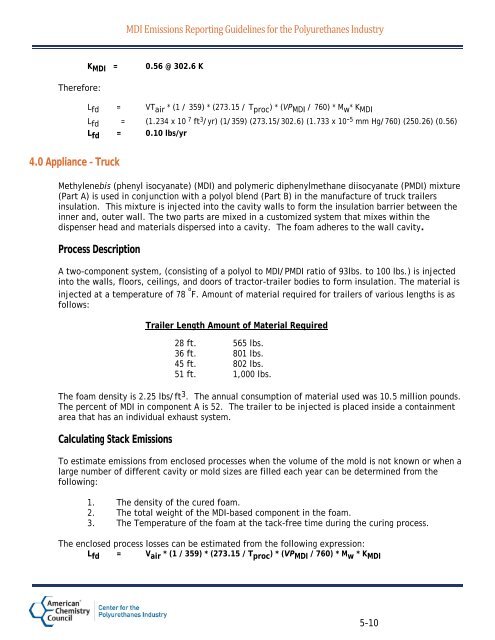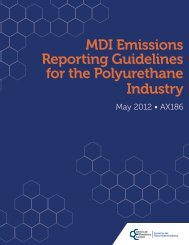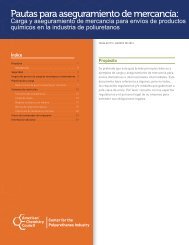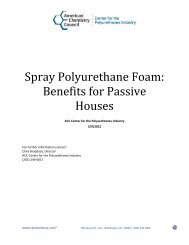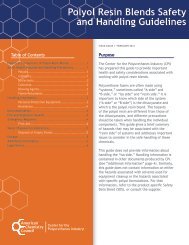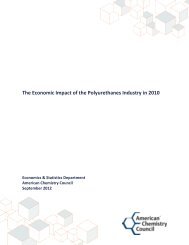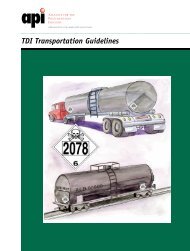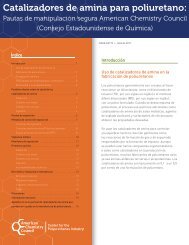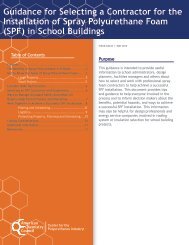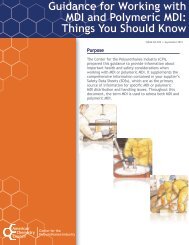MDI Emissions Reporting Guidelines for the ... - Polyurethanes
MDI Emissions Reporting Guidelines for the ... - Polyurethanes
MDI Emissions Reporting Guidelines for the ... - Polyurethanes
You also want an ePaper? Increase the reach of your titles
YUMPU automatically turns print PDFs into web optimized ePapers that Google loves.
There<strong>for</strong>e:<br />
4.0 Appliance – Truck<br />
<strong>MDI</strong> <strong>Emissions</strong> <strong>Reporting</strong> <strong>Guidelines</strong> <strong>for</strong> <strong>the</strong> <strong>Polyurethanes</strong> Industry<br />
K <strong>MDI</strong> = 0.56 @ 302.6 K<br />
Lfd = VTair * (1 / 359) * (273.15 / Tproc ) * (VP<strong>MDI</strong> / 760) * Mw * K<strong>MDI</strong> Lfd = (1.234 x 10 7 ft3 /yr) (1/359) (273.15/302.6) (1.733 x 10-5 mm Hg/760) (250.26) (0.56)<br />
Lfd = 0.10 lbs/yr<br />
Methylenebis (phenyl isocyanate) (<strong>MDI</strong>) and polymeric diphenylmethane diisocyanate (P<strong>MDI</strong>) mixture<br />
(Part A) is used in conjunction with a polyol blend (Part B) in <strong>the</strong> manufacture of truck trailers<br />
insulation. This mixture is injected into <strong>the</strong> cavity walls to <strong>for</strong>m <strong>the</strong> insulation barrier between <strong>the</strong><br />
inner and, outer wall. The two parts are mixed in a customized system that mixes within <strong>the</strong><br />
dispenser head and materials dispersed into a cavity. The foam adheres to <strong>the</strong> wall cavity.<br />
Process Description<br />
A two-component system, (consisting of a polyol to <strong>MDI</strong>/P<strong>MDI</strong> ratio of 93lbs. to 100 lbs.) is injected<br />
into <strong>the</strong> walls, floors, ceilings, and doors of tractor-trailer bodies to <strong>for</strong>m insulation. The material is<br />
injected at a temperature of 78 o<br />
F. Amount of material required <strong>for</strong> trailers of various lengths is as<br />
follows:<br />
Trailer Length Amount of Material Required<br />
28 ft. 565 lbs.<br />
36 ft. 801 lbs.<br />
45 ft. 802 lbs.<br />
51 ft. 1,000 lbs.<br />
The foam density is 2.25 lbs/ft 3 . The annual consumption of material used was 10.5 million pounds.<br />
The percent of <strong>MDI</strong> in component A is 52. The trailer to be injected is placed inside a containment<br />
area that has an individual exhaust system.<br />
Calculating Stack <strong>Emissions</strong><br />
To estimate emissions from enclosed processes when <strong>the</strong> volume of <strong>the</strong> mold is not known or when a<br />
large number of different cavity or mold sizes are filled each year can be determined from <strong>the</strong><br />
following:<br />
1. The density of <strong>the</strong> cured foam.<br />
2. The total weight of <strong>the</strong> <strong>MDI</strong>-based component in <strong>the</strong> foam.<br />
3. The Temperature of <strong>the</strong> foam at <strong>the</strong> tack-free time during <strong>the</strong> curing process.<br />
The enclosed process losses can be estimated from <strong>the</strong> following expression:<br />
L fd = V air * (1 / 359) * (273.15 / T proc ) * (VP <strong>MDI</strong> / 760) * M w * K <strong>MDI</strong><br />
5-10


